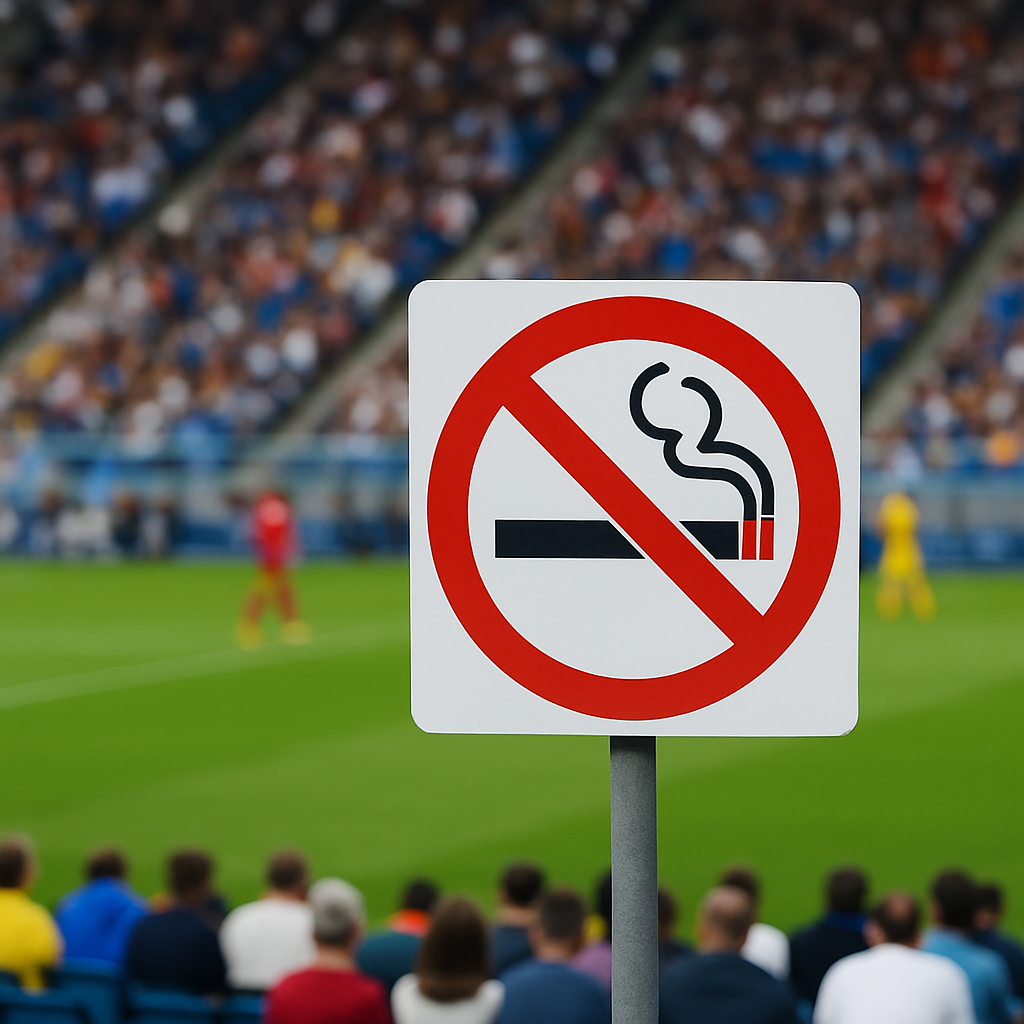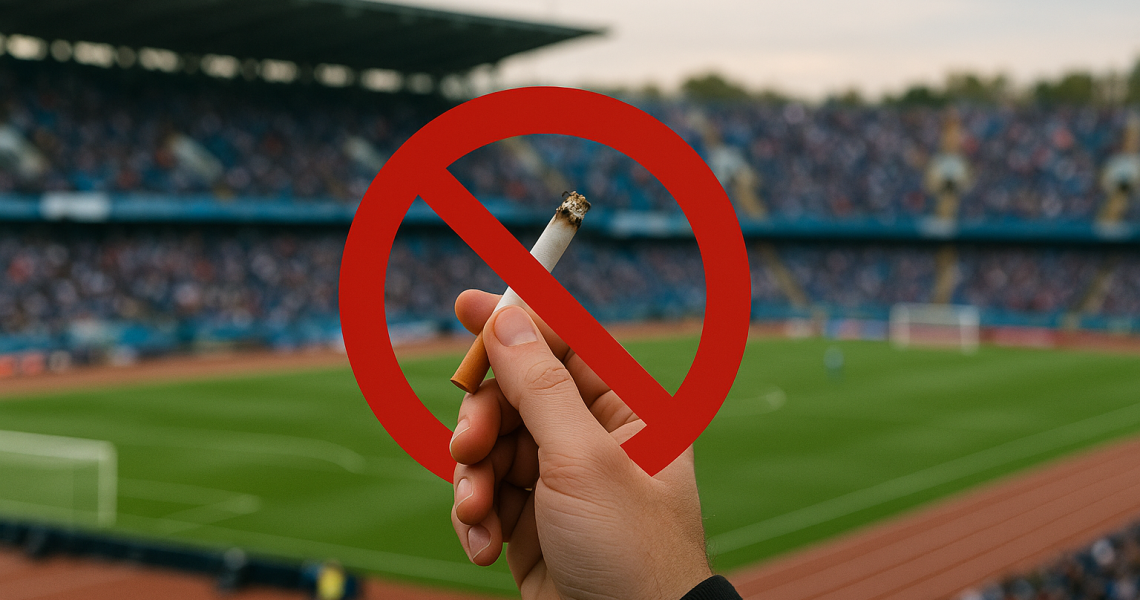Stadiums and sports venues are gathering places where the health and well-being of spectators, players and staff must be protected. For several years now, the fight against smoking in these public spaces has been intensified, with increasingly strict regulations. Is it still possible to smoke or vapourize in the stands during a soccer match? What are the penalties for offenders? Why was this ban introduced?
In this article, we’ll take a look at the rules in force, explain why the authorities have banned smoking in stadiums, and explore solutions for those who want to give up smoking for good.

A ban on smoking and electronic cigarettes in sports venues
French legislation on smoking in stadiums
In France, the Évin law, introduced in 1991, laid the foundations for the fight against smoking in public spaces. However, it was only with the evolution of regulations that stadiums and sports complexes became non-smoking areas. Today, smoking is strictly prohibited not only in indoor sports venues, but also in many open-air stadiums. This ban also includes electronic cigarettes, whose vapor can be a nuisance for spectators.
Penalties and fines in the event of infringement
A spectator caught smoking in a stadium is liable to a fixed fine of up to 450 euros. Sports clubs and event organizers also have the option of expelling smokers who fail to comply with the rules and regulations. What’s more, some stadiums simply forbid access to people carrying tobacco, forcing smokers to rethink their habits.
What are the exceptions? Are there areas reserved for smokers?
Some stadiums have set up specific areas for smokers, generally located outside the stands and main traffic areas. However, this practice is tending to disappear, as more and more sports venues adopt a zero-tolerance approach to smoking. Major international competitions such as the Football World Cup and the Olympic Games have also introduced 100% smoke-free zones, putting the emphasis on public health.
Why the ban on stadiums and sports venues?
Protecting the health of spectators and athletes
The ban on smoking in stadiums is part of a public health policy aimed at reducing exposure to passive smoking. At sporting events, spectators sit close together, which encourages the spread of smoke. For sportsmen and women, a healthy environment is essential, and the presence of smoke can be a source of discomfort, particularly for disciplines requiring a high respiratory capacity.
A desire to harmonize with international standards
Many countries have already adopted 100% smoke-free policies in stadiums and sports venues. In France, these restrictions are in line with the recommendations of theWorld Health Organization and international sporting bodies, which encourage the total elimination of smoking at sporting events.
A strong message for new generations
Stadiums and sporting events attract large audiences, including many young people and children. Banning smoking in these venues sends a clear message: tobacco has no place in an environment where performance, health and well-being are valued. The ban is also part of a wider drive to denormalize tobacco and reduce its appeal to younger generations.
Towards a ban extended to other public spaces?
The trend to ban smoking in outdoor areas
While stadiums are now affected by these restrictions, parks, beaches and outdoor leisure areas arealso beginning tofollow this trend. Several French municipalities have already adopted by-laws banning smoking in these places, in order to preserve air quality and combat the waste associated with cigarette butts.
Proposals from anti-smoking associations
Anti-smoking associations are campaigning for tighter bans, not just in stadiums, but also in busy public spaces. Some campaigns suggest going even further by banning smoking around schools, hospitals and even in public transport queues.
A likely change in legislation
Given the benefits observed with the ban on smoking in stadiums, it is highly likely that new legislative measures will be adopted to extend these restrictions to other venues. A generalized application of the law could encourage even more smokers to consider quitting for good.
An opportunity to quit for good
Why not take advantage of these restrictions to quit smoking?
Smoking bans in stadiums and public places are making it increasingly difficult to smoke. Rather than looking for temporary solutions, why not seize this opportunity to say goodbye to smoking once and for all? Quitting may seem difficult, but there are effective methods to help smokers make the transition.

The anti-smoking laser, an effective and natural solution
Among the most innovative methods, the anti-smoking laser stands out for its effectiveness and simplicity. An acupuncture-inspired technique, it stimulates reflex points in the ear to reduce cravings and alleviate withdrawal symptoms. Unlike nicotine substitutes, this approach does not prolong dependency, but acts directly on the brain to facilitate frustration-free withdrawal.
Support for a tobacco-free life
In addition to anti-smoking laserpersonalized support can optimize your chances of success. Practical advice, follow-up and stress management techniques can boost motivation and prevent relapse. Many former smokers testify to successful and lasting cessation thanks to this natural approach.
Conclusion
The ban on smoking in sports stadiums and venues marks a major step forward for public health. By reducing exposure to passive smoking and sending a strong message to the younger generation, these restrictions play an active role in the fight against smoking.
Rather than experiencing these prohibitions as a constraint, why not take advantage of them to free yourself from tobacco for good? With the anti-smoking laser, it’s possible to quit without stress, weight gain or frustration.
🚀 Don’t let laws dictate your relationship with tobacco: take the lead and make the choice for a cigarette-free life today!
If you want to stop smoking, book an appointment at one of our anti-smoking laser centers near you.
